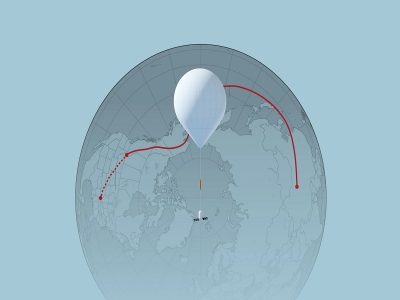Ballooning Rhetoric: Aliens, Escalation and Airborne Surveillance

All Global Research articles can be read in 51 languages by activating the Translate Website button below the author’s name (desktop version)
To receive Global Research’s Daily Newsletter (selected articles), click here.
Follow us on Instagram and Twitter and subscribe to our Telegram Channel. Feel free to repost and share widely Global Research articles.
***
Things are getting rather bizarre at the US Northern Command and the North American Aerospace Defense Command (NORAD). Its increasingly prominent commanding chief, one General Glen VanHerck, has abandoned any initial sense of frankness in discussing the destruction of an alleged Chinese surveillance balloon on February 4.
Since that disproportionately violent event, more public relations than sense, three other objects have also been destroyed. “We’re calling them objects, not balloons, for a reason,” the general said cryptically in remarks made on February 12. The briefing came in the aftermath of the downing of an octagonal-shaped object over Lake Huron on the US-Canada border.
Cultures of paranoia and suspicion approach such statements the way crops take to manure. The line between extra-terrestrial fantasies and human-made balloons can become grainy. Tinfoil hats become charged; fear finds a funnel to travel through. The suggestion from the general that “the intel community and the counterintelligence community figure that out” signalled an avalanche of speculation. This was given further impetus by VanHerck’s assertion that he “hadn’t ruled out anything” to a question on whether aliens featured in the mix. “At this point, we continue to assess every threat or potential threat unknown that approaches North America with an attempt to identify it.”
On February 13, the White House was left to deal with the excitement caused by the Pentagon’s speculations. Press Secretary Karine Jean-Pierre was given the bucket to dampen the enthusiasm. “I know there have been questions and concerns about this, but there is no sign, again no indication of aliens or extraterrestrial activity with these recent takedowns.”
John Kirby, coordinator for strategic communications at the National Security Council in the White House, was also adamant in his briefing: “I don’t think the American people need to worry about aliens with respect to these crafts, period.” Hardly reassuring to those glued to such reports as that from the Office of the Director of National Intelligence in June 2021, which refused to rule out the possibility that 144 unidentified aerial phenomena might have extra-terrestrial provenance.
The bafflement over these objects has added some zest to the already exaggerated China threat. It is a throwback to the Cold War, which was characterised by ill-educated second guesses about performance, capability, and awareness about an inscrutable enemy. Foes, drunk with threat inflation, jousted in the dark and groped in the wilderness, finding a mirage of reality.
With the latest belligerent undertakings by the US government, an escalation is being encouraged by the hawks in Congress. Kirby, wishing to add a sting to the China effort, told the press that Biden, on coming to office, directed the US intelligence community to conduct a broad assessment of Chinese intelligence capabilities. “We know that these [Chinese] surveillance balloons have crossed over dozens of countries on multiple continents around the world, including some of our closest allies and partners.”
This is hardly a unilateral game. Having accused Beijing of such airborne surveillance present and past, the Biden administration is now facing accusations of its own. According to the PRC, the US has conducted its own exercises in flying high-altitude balloons in its airspace – no fewer than 10 times last year. To that can be added hundreds of reconnaissance missions. “It’s very common that the US intrudes [into] others’ airspace,” remarked Chinese foreign ministry spokesperson Wang Wenbin, citing 657 sorties made by Washington in 2022 and 64 aircraft flights in January “over the South China Sea alone”.
Kirby was cocksure in denying such claims, even those alleged missions that might apply to Taiwan or the South China Sea. “There is [sic] no US surveillance aircraft over Chinese – in Chinese airspace.”
The Balloon Affair has also tickled the interest of Washington’s allies. Object fever is catching. The United Kingdom, that reliably unquestioning transatlantic appendage of US power, is hopping on the bandwagon. The country’s transport minister, Richard Holden, did not even care to cite any evidence of “Chinese spy balloons” making their way through British airspace. What mattered was that it was “possible” and “that there will be people from the Chinese government trying to act as a hostile state.”
Defence Secretary Ben Wallace further suggested, with forced graveness, that, “The UK and her allies will review what these aerospace intrusions mean for our security. This development is another sign of how the global threat picture is changing for the worse.” Blame it on those objects.
Prime Minister Rishi Sunak also reminded the good people of Britain that the country is ever vigilant to any incursions from hot air objects or anything similar to them. “We have something called the quick reaction alert force which involves Typhoon planes, which are kept on 24/7 readiness to police our airspace, which is incredibly important.”
Tobias Ellwood, Conservative chairman of the Commons defence select committee, swallowed the suggestion that those sneaky Orientals were “exploiting the West’s weakness” with their mysterious aerial instruments. At least there was no mention of aliens, but that is increasingly becoming a distinction without a difference.
*
Note to readers: Please click the share buttons above. Follow us on Instagram and Twitter and subscribe to our Telegram Channel. Feel free to repost and share widely Global Research articles.
Dr. Binoy Kampmark was a Commonwealth Scholar at Selwyn College, Cambridge. He currently lectures at RMIT University. He is a regular contributor to Global Research and Asia-Pacific Research. Email: [email protected]
Featured image is from Andrew Korybko

